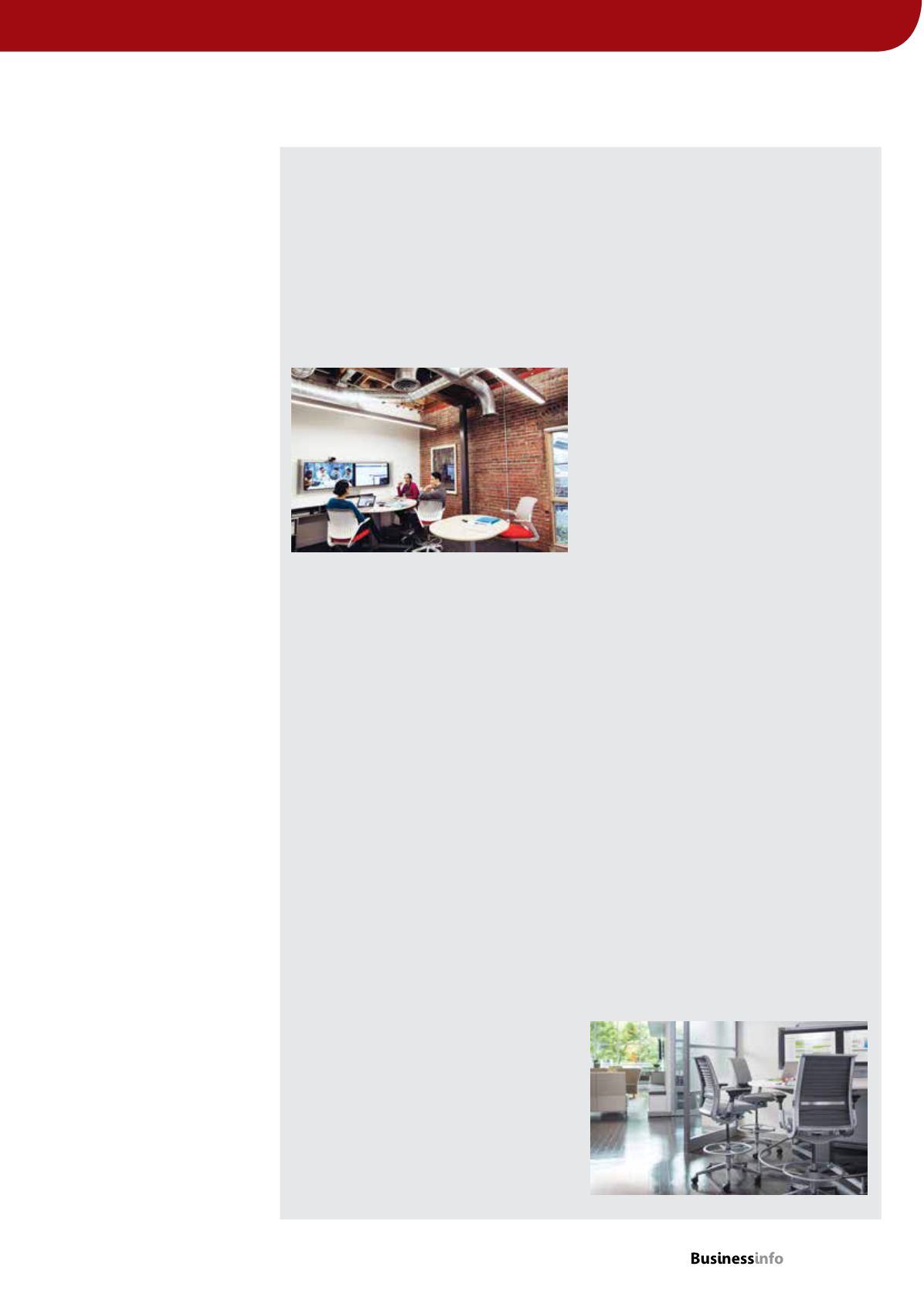
implement tools, such as cloud-based
productivity apps, to monitor worker
performance. A large proportion of
employees will actually enjoy the
freedom afforded to them and this will
lead to improved morale and output,”
he said.
“Whilst the office may disappear,
communication and physical interaction
with colleagues in close proximity
will still be necessary. Organisations
must ensure that staff attend regular
meetings with their peers and always
have the opportunity to use office
facilities if needed – which is where
rented or shared office spaces become
viable options.”
Team spirit
One organisation already working
without a fixed office is Nozbe, a fast-
growing app development company
and creator of a cross-platform project
and time management application
for business professionals. The firm
encourages its 18 employees to
collaborate by sharing files via Dropbox;
to communicate via instant messaging
service Slack; and to use Skype when
they require face-to-face interaction. In
order to build team spirit, the business
organises two employee meetings per
year at a hired venue.
Michael Siliwinski, founder of Nozbe,
said: “Offices are incredibly distracting
places to work in. At Nozbe, we are able
to start early and take breaks when we
want, ensuring maximum productivity.
However, it is important that we have
the right communication channels in
place so that everyone is aligned and
has a common understanding of team
activities and needs. Despite the fact
we all work from home, we actually feel
more connected than most workforces
that operate using traditional offices.”
Tim Meredith argues that the savings
associated with removing fixed property
costs are a ‘no brainer’ for established
businesses as they look to improve
performance.
“Eliminating fixed office space means
businesses can become more agile and,
most importantly, save thousands of
pounds which can be reinvested for their
staff and customers. The next generation
of workers are digital natives and at
ease using the technologies available, so
it really is a no-brainer to let them work
remotely,” he said.
Rules of engagement
Steelcase has produced six rules for successful video-conferencing
Cultivating trust and a good working
relationship between colleagues based in
different locations is a major challenge for
multinational companies. So how can senior
executives ensure that a workforce spread
across the globe is working as efficiently and
productively as possible?
Steelcase, the world leader in the provision
of high performance workplace solutions, has
undertaken extensive research on how companies
can break down distance barriers and improve
communication between international colleagues.
“All humans crave eye contact and respond
to it in significant ways, which results in richer
communication experiences and helps build
trust,” says Beatriz Arantes, a SteelcaseWorkSpace
Futures researcher with an advanced degree in
environmental psychology.
“We’re adept at picking up subtle signals of
what people are thinking that may not even
register on a conscious level. Additionally, we
know that in some cultures, China, for example,
people derive more meaning from unspoken
signals than in countries such as the United
States, where a direct and explicit approach is
considered key.”
Visual cues help break down language barriers
among global teams. Different accents, different
dialects and differences in semantics can make it
difficult to understand certain words or phrases.
Being able to see confusion in a person’s eyes
gives you an immediate visual cue that you’re
not being understood, so you can restate or ask
for feedback. As a result, people become better
communicators and more sensitive to cultural
differences.
Optimising technology
Although video-conferencing is a growing
practice, it hasn’t solved all of these issues. Often
what’s missing is an understanding of how to
optimise video technology in a physical space to
make distance disappear.
Video-conferencing must make it possible for
workers not just to see and hear each other, but
also to co-create and have a common experience
no matter where they are located. To this end,
Steelcase has unveiled the six rules of successful
distance collaboration.
1
Consider camera and microphone placement
carefully. Develop a lay-out that allows all users
to be on camera and clearly audible. Include
multiple screens so participants can see each
other and their content at the same time, and
make sure people can move and stay on-camera
without disrupting the flow of interaction.
2
Create zones that allow people to move
fluidly between group work and privacy. People in
collaborative teams make quick switches between
these modes throughout the day. Enclaves
immediately adjacent to the team space allow
team members to get away without going away.
3
Design environments that encourage
movement and a range of postures so
participants can stay energised and engaged.
Stool-height tables encourage standing up
and staying on camera. A lounge setting with
video-conferencing is another effective way to
encourage movement and informality.
4
Think about both sides of the experience.
Provide similar environments in all locations,
equipped with the same level of tools and
controls. Incorporate abundant display surfaces,
both analogue and digital, to help distributed
teams develop a shared mind.
5
Consider how the space can build trust. For
instance, a ‘wormhole’, a continuously open,
real-time video connection that acts like an open
window between two locations can help promote
small social exchanges as people come and go.
6
Plan for a range of team sizes and video-
conferencing exchanges. One-on-one interactions
and small group work are as important as full
team sessions. Creating as many choices as
possible – including smaller video-conferencing
kiosks adjacent to the larger team space, nooks
within the large space and even mobile video-
conferencing technology – will leverage real
estate and encourage use of the technology.
01732 759725
35
magazine


